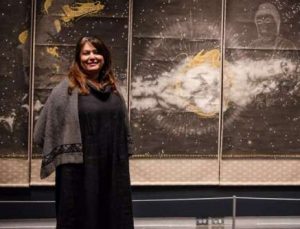
When we speak of our spiritual teachers, conversations naturally drift to thoughts about their presence, how they make us feel, why we looked up to them to begin with. If our teacher is legitimate and solid in the Dharma, among such feelings will be emotions such as gratitude, serenity, and contentment. Chokyi Nyima Rinpoche’s newest book Sadness, Love, Openness: The Buddhist Path of Joy is a little book of love that exudes the teacher’s presence. I am reminded of Mr. Hector’s address on reading in Alan Bennett’s 2006 film The History Boys: “The best moments in reading are when you come across something—a thought, a feeling, a way of looking at things—which you had thought special and particular to you.” While it is possible to attend Rinpoche’s empowerments and listen to his lectures if he is in your area, here he is, condensed in the pages of a book that he offers to us for “the purpose of realizing reality.”
The title of this book, Sadness, Love, Openness: The Buddhist Path of Joy, could belong to any secular self-help book, yet it is of great significance for the secular Buddhist. People want to have their sadness recognized for there is nothing more painful and dark than having one’s sadness dismissed. People want to feel loved, but they also feel scalded by its more volatile forms and hence betrayed. They want authentic and sustainable love that transcends the transitory, that truly endures at a “spiritual” level, regardless of one’s religious or non-religious beliefs. And despite how everyone seems to instinctively close up or shut down in the face of bold new perspectives and possibilities, daring to open up to the bodhisattva path will set one on the path of true meaning and happiness.
The structure of this short book is easy to apprehend, and the teachings within are accessible and general in nature. In the first section, “Sadness,” Rinpoche notes: “Reflecting on impermanence is not meant to make us miserable. But without that sorrow of knowing nothing will last, we will never get anywhere on our path. Sadness makes it possible for us to gain something that is much more precious than we can imagine.” He goes on to write: “The profound disillusionment that inevitably follows the recognition of impermanence is both natural and necessary. We shouldn’t shy away from it, because love is born from that sorrow, and love yields insight into the way things really are.”
Through the experience of sadness, we touch the next dimension. This is the experience of “Love,” the Buddha’s love and the knowledge of Dharma that he transmitted. Through this knowledge we can transform ourselves and pass on its efficacy to others for their own spiritual growth. Of course, some people are simply stuck in their habitual emotions, feeling sad one moment, then happy the next. As Rinpoche puts it: “As long as we have not acknowledged the impermanent nature of things, we continue to be fickle and unreliable. The encounter with impermanence awakens us abruptly, but until that happens, we’re like passed-out drunks.”

In the second chapter on the topic of “Love,” Rinpoche understands the need for language that can express conventional or provisional truth (samvrti-satya), indeed he notes that understanding reality as it appears to other subjective agents (for we are subjective agents ourselves) is a stepping stone to further insight. “It’s important that we understand both dimensions: reality as it appears to others and reality as it actually is. . . . We can’t simply write off what others experience as ‘wrong’ and leave it at that. . . . No matter how confused and deluded we may be, we instinctively feel that our experience is real.” There are many paths to practice, but Rinpoche outlines some of the contours of the general, pan-Buddhist vision of the path throughout the chapter, from faith to cultivating natural presence. These issues are highlighted poetically and eloquently, with dozens of subjects addressed with compassion and erudition.
In his third and final chapter, Rinpoche explores the notion of openness in two respects: how to open oneself up to the truth, but also how to engage in the act of being open itself: put another way, openness is its own way of being, and characterized by the increasingly focused, pinpointed path of Vajrayana. Rinpoche starts on a general note, and reminds us: “Happiness and the cause of happiness can arise only through loving-kindness and insight into the nature of things. There is no other way.” He then highlights the components of the bodhisattva path, before expanding onto the path of the Diamond: Vajrayana Buddhism, specifically.
This is where Rinpoche goes more into more orthodox Vajrayana doctrine, from the four outer preliminary practices to the inner preliminary practices. The uniqueness of this concluding segment is Rinpoche’s articulation of “thought-free wakefulness,” which is what I understand to be the penultimate state of the journey to enlightenment itself on the Vajrayana path. It transcends meditation itself. As Rinpoche writes:
“Only a complete absence of thoughts can free us. We must achieve a state of wakefulness that is perfectly clear and thought-free. For that, no sort of meditation training is going to be useful because there is nothing to keep in mind, nothing to focus on, and nowhere to direct our attention. . . . Thought-free wakefulness dissolves the grip of our ignorant, dualistic mind. Thought-free wakefulness blows up the grammar of ordinary consciousness and goes beyond subject, object, and action. Thought-free wakefulness cannot be grasped by thought. It is—quite literally—unthinkable. Still, we can train our consciousness to recognize it.”
Chokyi Nyima Rinpoche has penned a truly lovely, compact manual of the Buddhist path. Both perceptive and kindhearted, the book radiates Rinpoche’s presence. I would say that seekers who wish a relatable and simple springboard that catapults them deep into the heartland of enlightened thinking and activity should engage seriously with this digest.














